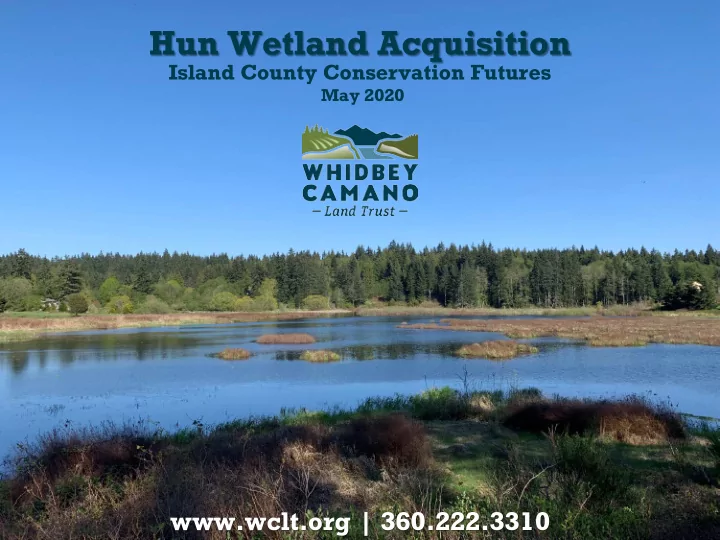

Hun Wetland Acquisition Island County Conservation Futures May 2020 www.wclt.org | 360.222.3310
Land Trust Overview • Non-profit conservation organization • Founded 1984 • Donor supported operations • Non-regulatory and non-partisan • Willing landowners • Nationally accredited 2
Land Protection and Resource Stewardship Number of Properties Land Trust Protection Project Types: Conservation Easements = 66 Number of Acres Facilitated Projects = 20 Fee Title Ownership = 28 3
Intro: Project Location 4
Intro: Project Vicinity 5
Intro: Project Watershed 6
Intro: Project Parcel 7
Intro: Project Background 8
Intro: Project Goal & Objectives Protect riparian and wetland habitat from development to provide support salmonid recovery within Puget Sound Protect wildlife movement corridors in Island County. Preserve scenic and open space resources Provide economic opportunities Educate the public on the benefits of conservation 9
Intro: Project Budget Project Funding Sources CFF Grant Proposal $175,000 (73%) (requested) Matching Funds $65,000 (27%) Private Funding (secured) Total Project Cost $240,000 (100%) 10
A.1.a. Conservation Values & Resources: Significance 11
A.1.a. Conservation Values & Resources: Significance Preservation of a Critical Water Resources Glendale Creek: Chinook salmon, Coho salmon, Fall chum salmon, and Cutthroat trout Glendale Watershed: Migratory birds, raptors, amphibians, and mammals Wetlands and Riparian Habitat: Aquifer recharge/groundwater protection Flood prevention Groundwater recharge 12
A.1.b. Conservation Values & Resources: Rarity 13
A.1.a. Conservation Values & Resources: Rarity Preservation of a Critical Fish and Wildlife Habitat Glendale Creek Watershed: Project is located within the headwaters of Glendale Creek, one of only two salmon-spawning streams on Whidbey Island, and three in all of Island County. Priority area for protection: WRIA 6 Multi-Species Salmon Recovery Plan & Recovery Plan Update (2019) Previous conservation/restoration investments in the watershed 14
A.1.a. Conservation Values & Resources: Significance 15
B. Appropriate Public Use & Enjoyment 16
B. Appropriate Public Use & Enjoyment 17
B. Appropriate Public Use & Enjoyment 18
C.1. Plans & Partnerships: Local Plans Land Use Element 19
C.1. Plans & Partnerships: Local Plans Natural Resources Element Project Location 20
C.1. Plans & Partnerships: Local Plans Natural Resources Element Continued Project Location 21
C.1. Plans & Partnerships: Local Plans Natural Resources Element Continued Project Location 22
C.1. Plans & Partnerships: Local Plans Parks and Recreation Element Project Location 23
C.1. Plans & Partnerships: Local Plans Parks and Recreation Element Continued Project Location 24
C.1. Plans & Partnerships: Local Plans Project Project Location Location WRIA 6 Multi-Species Salmon Recovery Plan & Recovery Plan Update (2019): High priority for juvenile salmon habitat protection 25
C.2. Plans & Partnerships: Support Local Landowners 26
D.1. Potential for Loss: Immediacy of Loss Matching Funds Secured Landowner Willingness 27
D.1. Potential for Loss: Immediacy of Loss 28
D.2. Potential for Loss: Acquisition Timing Photo: E.R. Keeley Photo By: Craig Johnson Photo By: Heide Island Photo: E.R. Keeley Photo By: Craig Johnson 29 Photo: WCLT Staff Photo: Roger Tabor/USFWS
E.1 & 2. Stewardship Viability: Needs/Risks Nationally accredited (LTA) Dedicated Stewardship Staff Dedicated Stewardship Funds - Stewardship Reserve - Stewardship Enhancement - Restoration - Legal Defense Nearly 10,000 Acres Protected 30
E.3. Stewardship Viability: Long-Term Costs Habitat improvement projects Invasive species monitoring/removal Encroachment monitoring/debris removal Environmental education/outreach 31
F.1. Financial Strategies: Cost Efficiencies CFF = 73% of project cost Matching Funds = 27% of project cost Land Trust Stewardship = Perpetuity 32
F.2. Financial Strategies: Future Costs Land Trust Members Land Trust Staff Volunteer Stewards 33
Thank You! www.wclt.org | 360.222.3310
Recommend
More recommend